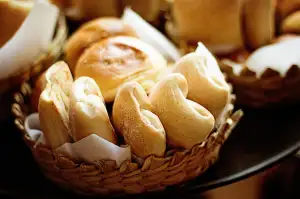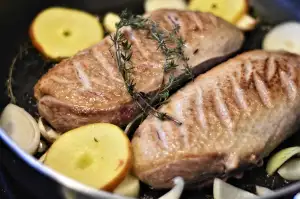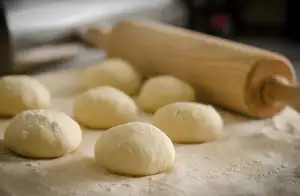Cast Iron Skillet Cornbread: A Rustic Delight to Savor

- Step 1: Gather the Ingredients for Homemade Cornbread
- Step 2: Preparing the Cast Iron Skillet for Baking
- Step 3: Mixing the Cornbread Batter
- Step 4: Preheating and Pouring the Batter into the Skillet
- Step 5: Baking the Cornbread to Perfection
- Step 6: Serving and Enjoying the Delicious Cornbread
- Tips and Variations for Perfecting Your Cornbread Recipe
Cornbread, a beloved staple of Southern cuisine, holds a special place in the hearts and palates of food enthusiasts worldwide. Its golden crust, moist interior, and rich flavor make it a versatile accompaniment to any meal. And what better way to prepare this timeless delight than in a trusty cast iron skillet? The cast iron skillet not only imparts a rustic charm to the cornbread but also ensures even heat distribution for that perfect texture. Join us on a flavorful journey as we explore the art of making cast iron skillet cornbread and discover the endless possibilities it offers.
Step 1: Gather the Ingredients for Homemade Cornbread
To embark on your flavorful cornbread adventure, you'll need to gather a few key ingredients. Here's what you'll need:
- 1 cup of yellow cornmeal
- 1 cup of all-purpose flour
- 1 tablespoon of baking powder
- 1/2 teaspoon of salt
- 1/4 cup of granulated sugar (optional, for a touch of sweetness)
- 1 cup of buttermilk (or substitute with regular milk)
- 2 large eggs
- 1/4 cup of unsalted butter, melted
Make sure to have these ingredients on hand before diving into the delightful process of making homemade cornbread in a cast iron skillet.
Step 2: Preparing the Cast Iron Skillet for Baking
Before you start mixing the cornbread batter, it's important to properly prepare your trusty cast iron skillet. This step ensures that your cornbread bakes evenly and develops a beautiful golden crust.
First, preheat your oven to the desired temperature specified in your cornbread recipe. While the oven is heating up, place the cast iron skillet on the stovetop over medium heat.
Next, add a small amount of oil or melted butter to the skillet. Use a brush or paper towel to evenly coat the entire surface of the skillet, including the sides. This will prevent your cornbread from sticking and make it easier to remove once baked.
Allow the skillet to heat up for a few minutes until it becomes hot to touch. This step helps create a crispier crust on your cornbread.
Once heated, carefully remove the skillet from the stovetop and set it aside momentarily. Be sure to use oven mitts or potholders as the handle will be extremely hot.
Now that your cast iron skillet is prepared, you're ready to move on to mixing together all those delicious ingredients for your homemade cornbread batter.
Step 3: Mixing the Cornbread Batter
Once you have gathered all the ingredients for your homemade cornbread, it's time to mix them together to create a delicious batter. In a large mixing bowl, combine the cornmeal, flour, sugar, baking powder, and salt. Whisk these dry ingredients together until they are well combined.
In a separate bowl, beat the eggs and then add in the buttermilk and melted butter. Whisk these wet ingredients together until they are fully incorporated.
Next, pour the wet ingredients into the bowl with the dry ingredients. Using a spatula or wooden spoon, gently fold the wet and dry ingredients together until just combined. Be careful not to overmix as this can result in a dense cornbread.
You may also choose to add some additional mix-ins at this stage such as shredded cheese, diced jalapenos, or cooked bacon for added flavor and texture. Simply fold them into the batter along with the wet and dry ingredients.
The final result should be a slightly lumpy batter that is moist but not overly wet. If it seems too dry, you can add a splash of buttermilk or milk to achieve the desired consistency.
Now that your cornbread batter is mixed and ready to go, it's time to move on to step 4: Preheating and Pouring the Batter into the Skillet.
Step 4: Preheating and Pouring the Batter into the Skillet
Before pouring the cornbread batter into the skillet, it's important to preheat it properly. This step ensures that your cornbread cooks evenly and develops a delicious golden crust.
To preheat the skillet, place it in a preheated oven at 425°F (220°C) for about 10 minutes. This will allow the skillet to get hot and create a sizzling effect when you pour in the batter.
Once the skillet is hot, carefully remove it from the oven using oven mitts or heat-resistant gloves. Be cautious as it will be extremely hot!
Next, quickly pour your prepared cornbread batter into the hot skillet. The sizzling sound that follows is music to any food lover's ears.
Using a spatula, spread the batter evenly across the surface of the skillet. Make sure to reach all corners and edges for consistent baking.
Now, return the skillet to the oven and let it bake for approximately 20-25 minutes or until a toothpick inserted into the center comes out clean.
During this time, resist opening the oven door too often as this can cause fluctuations in temperature and affect your cornbread's texture.
As you wait for your cornbread to bake, you'll be greeted by an irresistible aroma wafting through your kitchen.
Remember that cooking times may vary depending on your oven, so keep an eye on your cornbread towards the end of baking to avoid overcooking.
Once baked to perfection, remove the skillet from the oven and set it aside to cool for a few minutes before serving.
The result? A beautifully golden and moist cornbread with a slightly crispy crust that will leave you craving more. Get ready to indulge in this rustic delight!
Step 5: Baking the Cornbread to Perfection
Once your batter is poured into the preheated cast iron skillet, it's time to bake it to golden perfection. Place the skillet in a preheated oven at 425°F (220°C) and let the cornbread bake for about 20-25 minutes.
Keep an eye on it as baking times may vary depending on your oven. You'll know it's done when the top is golden brown and a toothpick inserted into the center comes out clean.
Avoid opening the oven door too often during baking as this can cause fluctuations in temperature and affect the texture of your cornbread.
When it's ready, carefully remove the skillet from the oven using oven mitts or pot holders. The aroma of freshly baked cornbread will fill your kitchen, enticing everyone nearby.
Allow the cornbread to cool for a few minutes before slicing and serving. The crust should be crispy while the inside remains moist and tender.
Baking cornbread in a cast iron skillet creates a beautifully even heat distribution, resulting in a perfectly cooked bread with a delightful rustic charm.
Step 6: Serving and Enjoying the Delicious Cornbread
Once your cornbread is baked to golden perfection, it's time to savor the delightful flavors. Carefully remove the cast iron skillet from the oven using oven mitts or pot holders, as it will be hot. Allow the cornbread to cool for a few minutes before cutting into slices.
Serve the warm cornbread alongside your favorite dishes, such as chili, soups, or barbecued meats. The rustic texture and rich flavor of the cornbread will complement any meal. For an extra touch of indulgence, spread some butter or drizzle honey over each slice.
Cornbread can also be enjoyed on its own as a tasty snack or breakfast treat. Its versatility allows you to experiment with different toppings and accompaniments. Try serving it with whipped cream and fresh berries for a sweet twist, or pair it with savory spreads like cream cheese or avocado.
Remember to store any leftover cornbread in an airtight container at room temperature for up to three days. To reheat, simply place individual slices in a toaster or warm them in a preheated oven until heated through.
Whether enjoyed as part of a comforting meal or as a standalone delight, homemade cornbread from a cast iron skillet is sure to satisfy your taste buds and leave you craving more of its rustic charm.
Tips and Variations for Perfecting Your Cornbread Recipe
1. Experiment with different types of cornmeal to find your preferred texture and flavor. Fine-ground cornmeal will result in a smoother, more delicate cornbread, while coarse-ground cornmeal will give you a heartier, rustic texture.
2. Add some extra flavor to your cornbread by incorporating ingredients like chopped jalapenos, shredded cheese, or cooked bacon into the batter. These additions will add a delicious twist to the traditional recipe.
3. For a sweeter version of cornbread, try adding a tablespoon or two of honey or maple syrup to the batter. This will give your cornbread a subtle sweetness that pairs well with savory dishes.
4. To make your cornbread more moist and tender, consider adding buttermilk instead of regular milk. The acidity in buttermilk helps to activate the leavening agents in the batter, resulting in a lighter and fluffier texture.
5. Don't overmix the batter! Overmixing can lead to tough and dense cornbread. Mix just until all the ingredients are incorporated for a tender crumb.
6. If you prefer a crispy crust on your cornbread, melt some butter in the skillet before pouring in the batter. The butter will create a deliciously golden and crunchy exterior.
7. Leftover cornbread can be transformed into delightful dishes like croutons for salads or stuffing for poultry. Simply cube the leftover bread and toast it in the oven until crispy.
8. Feel free to experiment with different herbs and spices to customize your cornbread's flavor profile. Try adding rosemary, thyme, paprika, or cayenne pepper for an extra kick.
By following these tips and exploring variations, you can perfect your own unique version of cast iron skillet cornbread that suits your taste preferences and culinary creativity!
In conclusion, the cast iron skillet cornbread is a delightful and rustic dish that brings together the flavors of tradition and simplicity. By using a cast iron skillet, you can achieve a golden crust and moist interior that will leave your taste buds craving for more. Whether you enjoy it as a side dish or as the star of your meal, this versatile cornbread recipe is sure to impress. So, why not embrace the timeless tradition of baking cornbread in a cast iron skillet? Give it a try and savor the deliciousness that awaits!
Published: 21. 12. 2023
Category: Recipes



